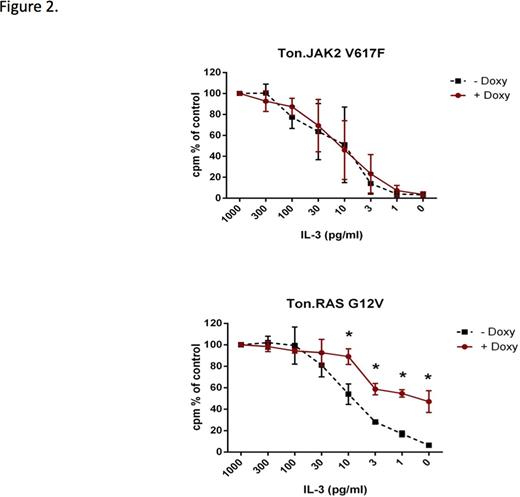Abstract
Background: Chronic myelomonocytic leukemia (CMML) is a hematopoietic malignancy with features of both a myelodysplastic syndrome and a myeloproliferative neoplasm.The pathogenesis of CMML is incompletely understood due to the large heterogeneity of molecular aberrations in genes involved in epigenetic regulation, RNA-splicing and signal transduction including components of RAS and JAK2 signaling. Functional tests may be important to better estimate the contribution of a particular molecular aberration in the pathogenesis of the malignancy. We have originally demonstrated extensive in vitro formation of myeloid colonies (CFU-GM) without addition of exogenous growth factors in a subset of patients with CMML (Geissler et al, Leuk Res 1988). We reported that this spontaneous CFU-GM colony formation in CMML is a GM-CSF dependent in vitro phenomenon (Geissler et al, J Exp Med 1996) and could also show in a small retrospective study that CMML patients with high spontaneous CFU-GM growth (>100/105 PBMNC) have a worse prognosis compared to patients with low myeloid colony formation (Sagaster et al, Ann Hematol 2004) suggesting a clinical significance of our observation. In juvenile myelomonocytic leukemia, in which molecular aberrations are mainly restricted to the RASopathy genes including NRAS, KRAS, NF1, CBL and PTPN11, spontaneous formation of CFU-GM due to GM-CSF-specific hypersensitivity is a hallmark feature of disease, which has been included in the diagnostic criteria. We therefore speculated that high spontaneous myeloid colony formation in CMML might also reflect hyperactivation of the RAS signaling pathway.
Aim: Our aim was to study the correlation between spontaneous myeloid colony formation and the presence of mutations in RASopathy genes in patients with CMML. Moreover the relationship of high autonomous CFU-GM formation with phenotypic features of CMML and its clinical outcome was investigated.
Patients and Methods: In this study we included 137 CMML patients of the "Austrian Biodatabase for CMML (ABCMML)" in whom CFU-GM data and/or molecular data were available. CFU-GM growth in the absence of exogenous cytokines was assessed in a central laboratory using semisolid cultures as previously described (Geissler et al, J Exp Med 1996). Molecular characterization was also performed in a central laboratory using NGS with amplicon-based target enrichment of 39 CMML associated genes. Assuming that clones that are too small are unlikely to significantly impact hematopoiesis only mutations with an allele burden of ≥20% were considered positive in this analysis. Clinical and hematological data were obtained from patients records.
Results:High spontaneous CFU-GM growth (≥100/105 PBMNC) was found in 38/135 (28%) CMML patients, of whom 3 were already transformed into secondary AML at the time of in vitro culture testing. There was a significant correlation between high CFU-GM formation in vitro and the presence of mutations in genes involved in the RAS signaling pathway. The incidence of RAS pathway mutations was 72% in CMML patients with high colony growth and 31% in patients with low spontaneous CFU-GM formation (p<0.0001). As shown in Table 1 high spontaneous myeloid colony formation was associated with increased WBC counts, increased blast cells, increased LDH, more pronounced splenomegaly and inferior survival (Fig. 1). There was no significant difference regarding autonomous CFU-GM growth in CMML patients with molecular aberrations in genes of epigenetic regulation and RNA-splicing, respectively. High spontaneous CFU-GM was never observed in CMML patients in whom the JAK2 V617F mutation was the only molecular aberration in signaling pathways (0/8 patients). Furthermore the in vitro conversion from a growth factor dependent to a growth factor independent phenotype by RAS but not by JAK2 could be demonstrated in BaF3 cells (Fig. 2).
Conclusion: Our findings indicate that high spontaneous in vitro myeloid colony formation is associated with the presence of RAS pathway mutations, leukocytosis, splenomegaly and reduced survival. These results suggest that CMML with high spontaneous colony growth is a mainly RAS pathway driven malignancy resulting in myeloproliferation and inferior outcome. This may have clinical implications concerning therapeutic strategies aimed at targeting the hyperactive RAS signaling pathway in these patients.
Geissler:Novartis: Honoraria. Pfeilstöcker:Novartis: Consultancy, Speakers Bureau. Burgstaller:Novartis: Consultancy, Honoraria. Zach:Novartis: Other: Honoraria for Advisory Board. Hörmann:Novartis: Other: Honoraria for Advisory Board. Jäger:Roche: Other: Personal fees, Research Funding. Sperr:Amgen: Honoraria, Research Funding; Novartis: Honoraria. Kusec:Novartis: Other: Honoraria for lectures. Valent:Amgen: Honoraria; Novartis: Honoraria, Research Funding; Celegene: Honoraria, Research Funding.
Author notes
Asterisk with author names denotes non-ASH members.




This feature is available to Subscribers Only
Sign In or Create an Account Close Modal